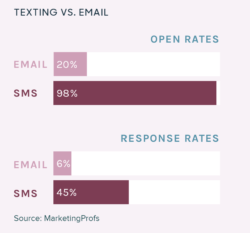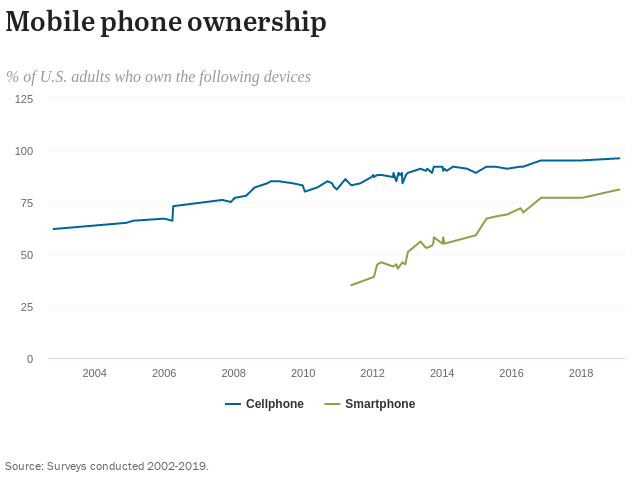Customer experience is everything. It’s the ingredient that sets you apart. It sparks business growth and promotes customer loyalty and retention. A positive CX ultimately affects your bottom line. In fact, customer-centric companies are 60% more profitable than companies that aren’t. So, how do you support your customer experience in your call center? Add business texting.
Ok, maybe I’ve lost you. Let’s walk through how adding texting to your customer service will refresh your customer experience:
Every interaction between a business and its customer is a conversation. As a result, customers more and more prefer to reach companies through messaging. According to surveys conducted by Zendesk, messaging by text and live chat are the future for building a successful customer experience. Why? Well, shockingly enough, your customers don’t actually want to sit on hold with your agents. And, they definitely aren’t thrilled when they’re stuck waiting a day or two to get an email back. They’re looking for fast and responsive service.

Conversational messaging is more effective than email, showing significantly higher open and response rates. Customers today want a personal, 1:1 conversation when they reach out to a company. But, what if you already have chat integration? Why should you need to add texting as a channel in addition to chat when chat seems to offer your company and customers the same benefits?
While live chat offers fast, real time service, it has its limitations. Let’s break those down:
Common Challenges Call Centers Face with Live Chat
Live chat is bound by operational and physical restraints that ultimately can harm your customer experience. Here are some challenges call centers face with chat:
1. Live chat is inflexible for your internal operations.
Chat sets the expectation that the customer will receive a response in less than 30 seconds to be considered a success. So, it requires an agent to be ready and waiting to immediately answer a customer. When a customer fills out a chat request and is told no representatives are available, it leaves a bad taste in their mouth.
But, hold up — have you been in a call center? This kind of flexibility is not always possible when phones are ringing off the hook and your team is understaffed. Chat establishes expectations with customers that realistically cannot always be met, thus negatively affecting your customer experience.
2. Live chat is inflexible for your customers.
Just as live chat requires your agents to be sitting ready and waiting before a computer screen, it also requires customers to wait. Let’s say it’s one of those days — your team is swamped. Customers are getting stuck talking with a bot on your live chat.
Customers choose live chat because it’s supposed to be quick and easy. It’s not convenient then for customers to get stuck sitting in front of their computer waiting for an available agent. On a bad day, live chat removes any form of convenience or possible flexibility for customer service.
3. When a chat is closed, it’s gone.
Chats are incredibly temporary. Once a conversation ends, your conversation’s history disappears. That means a new agent can’t pick up the conversation at a later date as easily. You don’t have as clear a record of your customer interaction. And, your customer can’t go back to reference their previously asked questions. Basically, everyone’s left in the dark, making crafting a customer experience tricky.
4. You’re stuck without much customer context.
In order to build a solid customer experience, your agents need to know your customers. It’s vital that every customer interaction, no matter the channel, can funnel its data to the same place. But, live chat is not always tied to your CRM. This means that your call center agents don’t have the same easy access to customer history or relationship context that occurred over chat.
Chat just cannot support your customer or your call center’s needs on its own. Add business texting and see a huge impact on your customer experience.
How Business Texting Helps Support your Customer Experience
At this point, nearly every American consumer owns a smartphone. According to Pew Research, as many as 97% of Americans now own a cellphone of some kind. And, as of 2021, the share of Americans that own a smartphone is now 85%. What’s the effect of this on your customer service and experience?

Customers want to be able to use that phone that’s in their back pocket to reach you. Text messaging hits customers right where they live, offering flexibility and ease unlike any other channel. As many as 78% of consumers wish they could text a business. That’s 78% of consumers telling you one way you could give them a better customer experience.
But, what makes it a better solution than live chat? Easy – Texting. In fact, texting is replacing live chat for your competitor’s on-the-go customers who want to connect when (and how) it’s convenient for them. Think about it: texting offers flexibility and accessibility in all the ways live chat can’t.
With text messaging, customers can communicate directly and conversationally with your business. The conversation stays logged for you and for the customer, retaining helpful details about the customer relationship and history. And, it gives your customers a place to go back to to find helpful guides, links, and media to answer their questions.
The channel offers more grace to your agents and customers, allowing for more natural pauses between replies. Customers can leave their computer to cook dinner or run to the store and still keep up the conversation. Agents get a breather between interactions, allowing for better internal operations, less stress, and more collaboration.
Integrate texting into your omnichannel solution for a more flexible way to support your customer base. Reach your customers where they are to provide a stronger customer experience.
Get results starting today with business texting from Textel.
This article originally published on March 24, 2021 and republished with updates on March 31, 2022.


